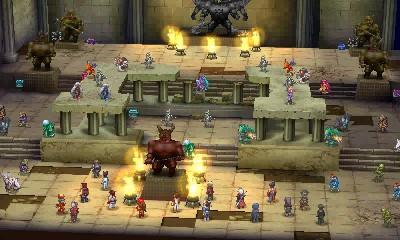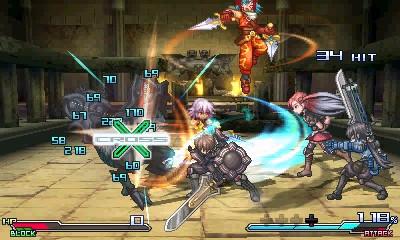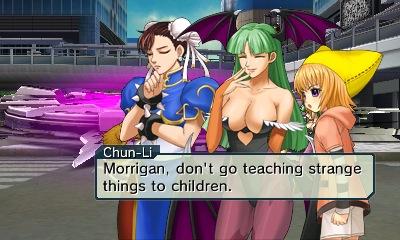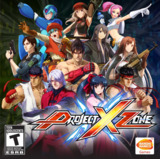20XX AD: A megalomaniac “Portalstone” disappears from the rich Kōryūji Estate. Boundaries between virtual worlds disappear and The World becomes real. And limitations between video game franchises disappear in a hybrid of thirty titles of all possible genres totalizing into one project partnered by Sega, Capcom, and Namco Bandai. As its title suggests, all is crossover in Project X Zone: the narrative, the characters, the design, the gameplay, and the music, and likewise in its earlier chapters alternating turns during a battle almost feels like shuffle-playing the tracks of a hyper-eclectic jukebox. Forget developing a single character and play with sixty at once instead, associated in fixed Pair and flexible Solo Units as different in game and design style as Neneko, Hsien-Ko, and Frank West; Dante, Demitri, and Devilotte; Gemini Sunrise and Tron Bonne; Kurt Irving and Valkyrie; or MegaMan's X and DmC's Lady. Whereas some of them stem from the game's 2005 forerunner, Namco X Capcom, its principal protagonists—Mii Koryuji, Kogoro Tenzai, the Belanos brothers, Due Flabellum, Meden Taore—as well as all the Oros Phlox pawns, are truly original here.
Still, the number of playable allies is more than doubled by the enemy characters most of which— Skeith, Astaroth, Selvaria Bles, Jedah Dohma, Nemesis T-Type, Dokumezu & Dokugozu—have to be defeated repeatedly in the 41 chapters of the more than 150 hours-long adventure that stitches together the scenes featured in the different games: the Mansion, the Bermuda, Japan, Basel, Paris, the Endless Frontier, the Demon World, to name a few, in reality counterfeit worlds of the real game worlds populated by similarly non-genuine foes, such as Feydoom, Gnosis, and Morolians. Whereas some—Heihachi, Saya, Juri Han—change sides after an initial confrontation, it is quite a bunch of bad guys that intends to profit—like Lord Raptor, Ciseaux, or Seth—from the chaotic condition in a boundless world where "space and time, past and future, life and death" has suddenly become meaningless. “Location doesn't matter, our battlefield is here” seems to be the central motto, and traveling is done, voluntarily or involuntarily, thanks to the dimensional rifts of a world out of sync with its own time era.

As for other turn-based tactical RPGs, the setting of every encounter is about as varied as the average chess game, that is, the basic layout—a defined number of pieces moved by turns on a (here) asymmetric grid—is more or less always the same. But notably much effort is made to make it more diversified: the win conditions—wipe out a certain/all enemies, not let a specific/all allies be defeated, reach a target within a limit of turns—may change up to three times during the battle, as usually additional foes (and friends) join the action, and every new chapter starts amidst the battlefield, embedded in often amusing manga-like dialogues.
As if considering every possible combination of the different Pair Units their number may vary between 6 and 20 being used during combat, as the friends are getting split into two or three groups to be reunited later again. The twenty available Solo Units that usually are reset at the end of a chapter furthermore add variation, albeit all mergers don't work equally well for some of the individual Skill Effects—Nullify enemy block, Heal HP 30%, Fixed enemy launch height, Attack range +1—might become redundant that way. In the hub in-between the chapters Gear and Accessory items unlocked during battle can be equipped to the Pair Units in order to permanently raise Health, Defense, Attack, Technique, or Speed, increase Experience, or protect against different types of ailments.
While the number of enemies on the battlegrid usually is the fourfold, Project X Zone is not really a difficult game to be played, and one might deplore the lack of true need for “tactical” concerns: although it is recommendable to quicksave frequently between turns, the rare “game over” happen only when not meeting the requirements within the (generous) time limit, usually 15 turns, or one of the excepted, non-rescuable Pair Units is defeated, which is, say, about five times in total. On the other hand, and unlike other tactical role-playing games, there is no real limit in applying Skills and Items before attack, so that one might handily cure / heal crew members and deplete one's Cross Power (XP) gauge prior to starting the next fight. Moreover, whereas Mii & Kogoro and their friends quickly level up and acquire new powerful attacks and skills, the enemies tend to just multiply their number (so that instead of initially one, one later gets two or more bosses at once).

The actual fights using the “Cross Active Battle System” might be where Project X Zone denotes most its Tekken, Street, and Virtua Fighters bonds: so instead of only one every single Pair Unit may link up to six different attacks (A + Circle/D-pad), plus that of the Solo Unit and any nearby Support Unit, which causes the stage to be agitated by up to six characters at once—an as colorful as noisily animated spectacle, in which also the fighters' different languages get mingled (“Let's rock”, “Bonjour”, “Ni hao”, “Adios”). Typical to fighting games, timing too matters here in order to have a hit become “Cross” or “Critical,” which not only adds to the damage inflicted to the respective enemy, but also serves as multiplier for the resulting XP gain.
The XP gauge is filled (up to 150%) with every attack sequence; at hundred percent it is also possible to Multi-attack several enemies in range (Start) or to perform a devastating Special attack (Y), either one resulting in a short anime-like cinematic. However, applying skills in order to heal 30% for an ally or oneself and nullify an enemy's block or cancel their counters consumes a specified amount of XP (between 10% and 130%), which then again has to be refilled in fight or compensated by a consumable item (defeated enemies often dispense consumables that else might be found in occasional chests).
While every Pair Unit possesses an equal amount of Skill Effects, those skills are not equally efficient in combat, although this may depend as well on the respective setting's circumstances: Nullify ZOC (Zone of Control) and Range+2 might be useful to avoid getting jammed in narrow terrain, whereas canceling blocks and counters is advisable against the bigger foes to increase attack efficiency without the risk of getting knocked out afterward. Curing health loss and ailments, on the other hand, does always come in handy, albeit the selected Pair Unit combinations might seem (purposefully?) unbalanced in this respect at times.
Spending so many hours with the personages of Project X Zone often familiar from other franchises of course creates also preferences, which might raise the question what one does prefer the different couples for: their combat efficiency, their narrative, their appearance, their individual tune, or perhaps a combination of all of this? True is that some of the Pair Units are more “useful” than others, in particular when combined with certain Solo Units, though the individual skills are not really static as they become more varied with time. Thus a couple like Zephyr & Leanne (Resonance of Fate) with Nullify enemy block & counters (plus Heal HP 30% and Range +2, e.g., when merged with Flynn) seems far more apt in combat than another one that in its stead has Fixed enemy launch height, First critical (Ally), and All parameters +10%, for blocked attacks often cause only few damage. Cute Kite and BlackRose (.hack), on the other hand, do not only have an interesting narrative—moreover as mysterious Aura's spirit force stars part of the storyline—but also a quite unforgettable musical theme (Stairways of Time, by Chikayo Fukuda).
The soundtrack as well as the colorful, well-rendered graphics both stand out in Project X Zone and are as contrasting and varied as are the games and characters they relate to; the theme tunes are associated to each Pair Unit (except several levels that use a more generic soundtrack) and in turn alternate with the respective Solo Unit's one, for instance, Kite & BlackRose's syncopated and Neneko's cheerful melody, or Mii & Kogoro's dynamic and Lindow's lyrical tune. To mention also that of Arthur (Ghosts 'n' Goblins), Kurt & Riela (Valkyria Chronicles III), Soma & Alisa (God Eater), as well as the one related to Oros Phlox (N.Tsuruyama, T.Hanaoka, K.Matsushima).

So what are the unpleasant tones in Project X Zone's eclectic medley: first of all, its epic length. As the initial thrill thanks to the fresh mixture of contrasting elements diminishes, the battles become repetitive and the storyline unnecessarily long-winded. For instance, the last episode and final boss battle following Chapter 40 alone take more than ten hours, concluded by an extended Farewell (“Sayonara”, “Zai jian”), and one notes well the desire to stretch the end more than necessary.
Another detail to criticize is the over-sexualization of many of the female characters, like Morrigan, Kaguya, and Aya-me, though all have their origins in other game titles, and although this very fact gets relativized through Frank's making “erotic” snapshots with his inseparable camera.
Yet while the positive prevails, after a full six and a half days the feelings when finishing Project X Zone are a bit mixed: relief, but also regret (one may start over using the last inventory), so it is fortunate that the game recalls so many games worth to be revisited: .hack, God Eater, Valkyria Chronicles, Sakura Wars... --Sayōnara, see you at the Portalstone!

